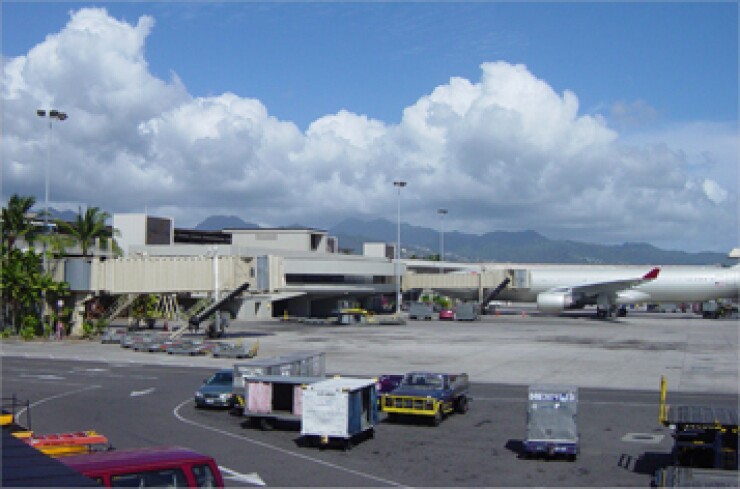
LOS ANGELES — The Hawaii Department of Transportation Airports Division will use a financing structure uncommon for airports to pay for $150 million in energy conservation projects.
The Airports Division plans to price $170 million in fixed-rate lease revenue certificates of participation on Dec. 10 and Dec. 11 to pay for energy conservation projects at 12 of the state's 15 airports.
The projects are part of a 20-year energy performance contract with Johnson Controls International anticipated to result in a 49% reduction of energy usage at the 12 airports, said Luis Salaveria, Hawaii's deputy finance director.
"The financing structure provides an innovative means to finance the projects and deliver operational costs savings for the Airports Division," Salaveria said.
The debt is structured as lease revenue certificates of participation payable from all net revenues of the Airports Division after payments are made on the $877 million in currently outstanding lease revenue bond debt, according to the preliminary official statement.
The COPs are fixed-rate with a 15-year maturity, and an increasing debt service profile structured to match the increase in annual energy savings guaranteed from Johnson Controls under the energy performance contract, according to a Fitch Ratings report. Interest on the COPs will be subject to the alternative minimum tax.
"The COPs structure is not common among airports," said Kurt Krummenacker, a vice president/and senior credit officer with Moody's Investors Service, who cited the complicated financing structure as a challenge in his rating report.
"There are other areas of public finance where COPs are more common, but this COPs structure and this type of contract with Johnson Controls is very rare among airports," Krummenacker said.
Salaveria agreed with Moody's evaluation that the structure adds an extra layer of financing complexity, but he added that investors in airport revenue bonds tend to be "fairly sophisticated and understand the complexities of municipal airport deals."
The COPs received an A3 rating from Moody's and A-minus ratings from both Standard and Poor's and Fitch. Those ratings are a notch lower than the airport division's outstanding lease revenue bond debt.
Analysts pointed to the airport's monopolistic nature in issuing the ratings. There's no other practical way for people to get on or off the islands.
"Air travel is essential for Hawaii due to a lack of alternative forms of transportation, providing the system with a stable origin and destination base of approximately 16.5 million enplaned passengers," Fitch analysts said in their report.
The impact on the Hawaii economy from the Great Recession was not as dire as it was for the other 49 states and the state bounced back faster, according to Ross Higashi, fiscal management officer for the Airports Division.
The airport has not provided any rate relief to the airlines in fiscal 2011, fiscal 2012 and fiscal 2013 and none is planned, according to the Moody's rating report.
"This move toward full cost recovery is a key positive for the system's credit, especially as it moves forward with its large capital plan," Moody's analysts said.
The Airports Division has $2.7 billion in capital improvements planned through 2018 expected to result in an additional $870 million in borrowing, according to the POS.
Johnson Controls was selected in September as the contractor on the $150 million project scheduled to begin in February 2014 and be completed two years later, Higashi said.
Of the $170 million Hawaii officials plan to price, $17.2 million will go into a 10% reserve fund.
As part of the contract, Johnson Controls guarantees that energy savings from the projects will exceed the cost of the lease payments, or it will make up the difference on the debt service payments.
If Johnson goes bankrupt, the airport will cover the costs.
Moody's rating is also based on an expectation that counsel will provide an opinion that the lease payments that go to repay the COPs could not get caught up in a bankruptcy of JCI, and thus be unavailable for payment to the certificate holders causing a payment default, Krummenacker said.
The airport system's signatory airlines have approved the energy projects and have agreed to include lease payments in their rates and charges, according to the preliminary official statement. They are obligated to cover debt service on the COPs in the event Johnson fails to perform or pay its obligations.
If the airport had used its more traditional method of financing debt through lease revenue bonds rather than using a performance contract, they would have needed to complete the projects piecemeal using contracts with each subcontractor, Higashi said.
It would have been unlikely the projects could have been completed in two years, he said.
"Every day the new systems are not installed, energy savings are lost," Higashi said. "We thought this was the most efficient way to do the total project."
Changing airport lighting systems to LED, replacing heating and air conditioning systems, electric transformers and installing solar panels over parking garages are the largest projects in the contract.
"We have older fixtures and 20-year-old heating and air conditioning systems," Higashi said. "It all needs to be replaced."
The projects are expected to result in $17.2 million in energy savings in the first year following product installation and increasing by 5% annually over the course of the 20-year contract for a total of $518 million in savings, Higashi said.
Morgan Stanley is the lead manager with Bank of America Merrill Lynch and JPMorgan as co-managers. First Southwest Co. is the financial advisor. Katten Muchin Rosenman LLP is bond counsel.





